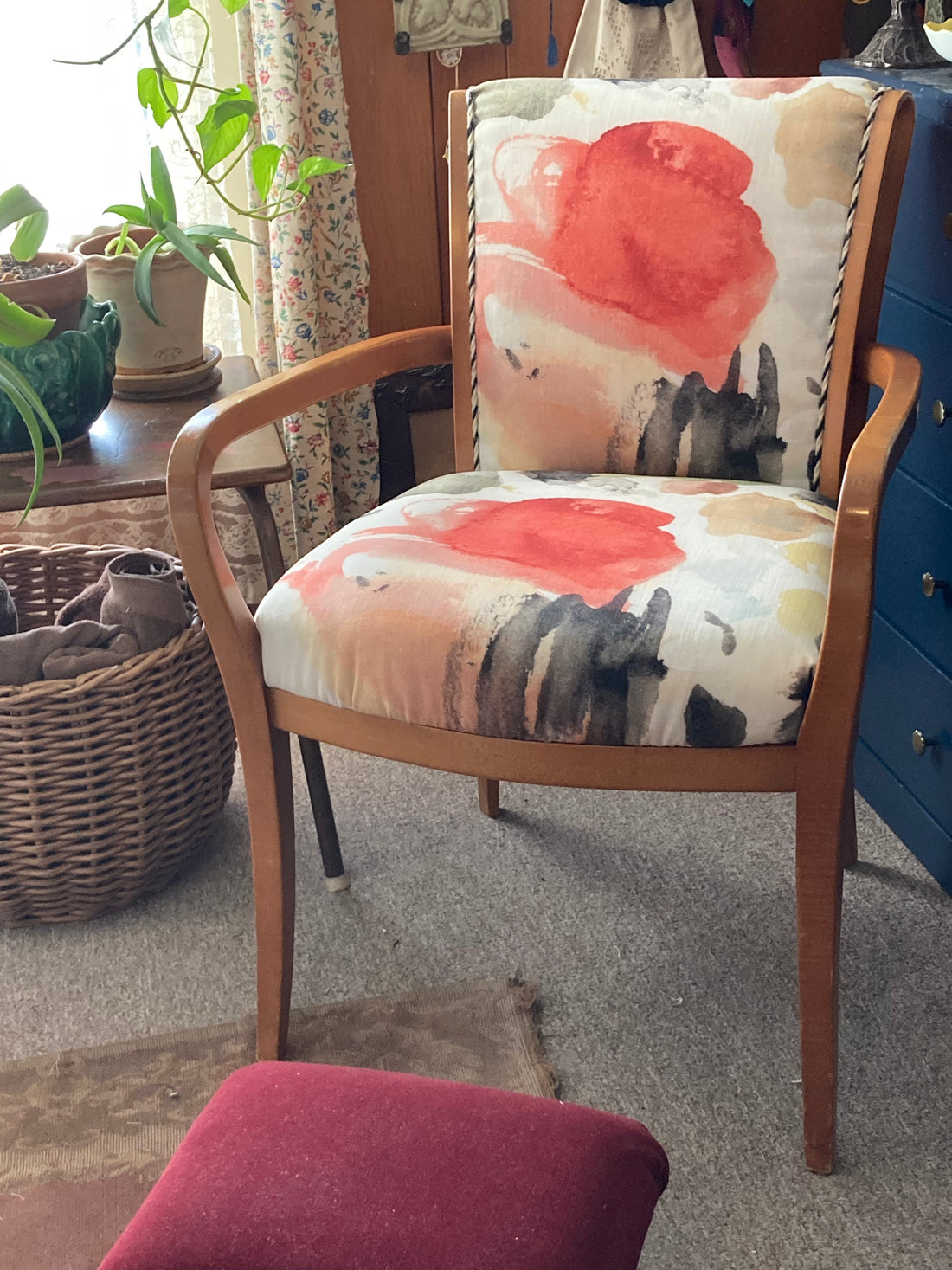
Thrifting for the Home
This is a typical office conference or waiting room chair, manufactured by Bernhardt, and purchased at our local Habitat ReStore a couple of years ago for $10. The fabric to reupholster it cost ten times that, but the leftover yardage enabled us to recover a second chair seat, and to make a throw pillow and a lampshade (sewn onto a frame purchased at Goodwill). The chair now sits in the meeting area of our attic workshop, and the lampshade adorns a flea market lamp across the room.

As these show, the thrift store can be a great launching pad for designing sustainable, timeless, and distinctly personal spaces in your home. You can create a unique atmosphere on a tight budget with thrifted and customized lighting, furniture, textiles, and accessories. In terms of both cost and sustainability, thrift shopping is the next best thing to shopping your own home for inspiration. Reusing and upcycling existing items rather than buying new is better for the planet and your budget. Besides being generally affordable, thrifting is free of the transitory joy of disposable trends and the uncertain burden of tariffs. Many thrift shops are operated by charitable organizations, so your purchases may also benefit others, further helping to make the world a better place.
Instead of trying to predict the newest styles and trends, thrifting offers a path to finding and refining your own personal style. Unlike most big box stores, thrift stores have a mix of today’s and yesterday’s trends and styles, and tons of stuff anyone might find fancy, fearless, or full of wonder. These stores are also home to a wealth of well-made, sturdy, and timeless pieces from companies like Stiffel, Thomasville, Bernhardt, Heywood Wakefield, and Frederic Cooper, as well as the familiar brands of today like Ikea, Crate & Barrel, and West Elm. Thrifting with your children can help them learn what features to look for and how things are made, and how to develop an eye for enduring style. Thrifting with your spouse or the whole family can help you construct a new and unique shared style as you search together for things you all agree on and love.
Here’s another peek at our attic workshop, this time the space where we sew the pillow covers we sell on these two modern sewing machines, a Juki serger and a Singer Heavy Duty (which replaced our 1960s Pfaff in 2023). The furniture, however, consists of several vintage Singer pieces purchased at ReStore over the last few years. The white table was $2, the brown table was $8 (neither had a machine inside), and the most expensive piece, the sewing chair with hidden storage in the seat, cost $12. We gave a light touch to the brown table, simply refinishing the top to create a smooth sewing surface, while the white table underwent major surgery. This table was originally vaguely colonial revival, with a maple finish and antique brass hardware. We removed the hardware, filled the holes, and painted the table white with some leftover paint. The “new” knobs are ones we bought on sale at Restoration Hardware twenty years ago for our kitchen, and have since replaced. Most importantly, we added a scrap-wood shelf inside the cabinet, three inches below the top, so the Singer Heavy Duty would sit at the correct height for sewing. The red velvet upholstery on the chair came from a thrifted glider we reupholstered a few years ago; we didn’t touch the finish on the wooden components of the chair.

If you are a crafter, experimenting on thrifted or found pieces is a low cost way to develop your skills and refine your style. With about $10 in supplies, and a YouTube tutorial on the underwriter’s knot, you can rewire most vintage lamps. Side tables, bookcases, and other case goods can enjoy a second life with a little leftover paint (or a newly purchased $6 paint sample can) and new or thrifted hardware. For children (or the young at heart), you can paint, stencil, or decoupage furniture and lampshades with animals, flowers, team colors, brand logos, robots, clouds, or camouflage. You can also follow some of our tutorials to create handmade lampshades, pouffes, and throw pillows out of thrifted curtains, bedspreads, and other textiles. Simple reupholstery tasks, like recovering dining chair seats or a headboard, may well lead to more complicated tasks as your grow your skills and confidence. Thrifting may empower you to discover new hobbies or even a side hustle.
In our home office, a large midcentury Stiffel lamp from Goodwill sits on a much more recent West Elm table found at ReStore. We recovered the original torn lampshade with a fabric remnant. We reupholstered the seat of the side chair (one of a pair by an unknown maker, from ReStore); the throw pillow is made from another fabric remnant. All told, we spent about $60 on this corner of the room (most of that for the chair and its partner on the other side of the room) and assembled it over several years.

As you explore thrift shops, estate sales, rummage sales, and things left on the side of the road, think about the small changes you can make to integrate your finds with your existing furniture and home décor. Thrifting is one of the easiest and cheapest ways to allow your home to change slowly over time, as you discover new favorite colors, styles, and fabrics, or your lifestyle changes and your spaces ask to be filled in new ways with different stuff. If you trust your skills to create something new and custom from something old, you will create an interior style unlike anyone else’s. Years ago, before catalogues, websites, and big box stores, this is how everyone decorated.
For more about slow decorating, click here
For more about pattern mixing and layering, click here
For more about family friendly design, click here
To browse and shop our Clearance collection, click here
